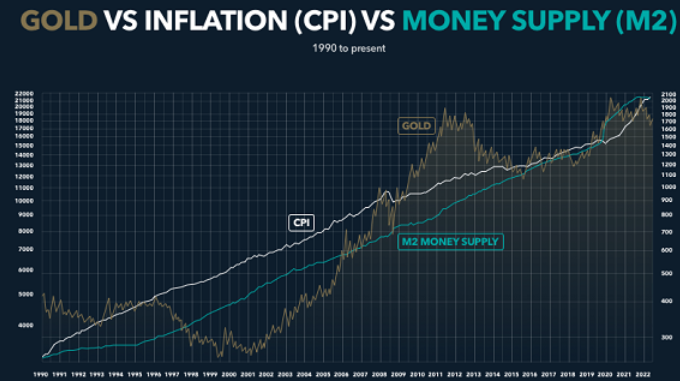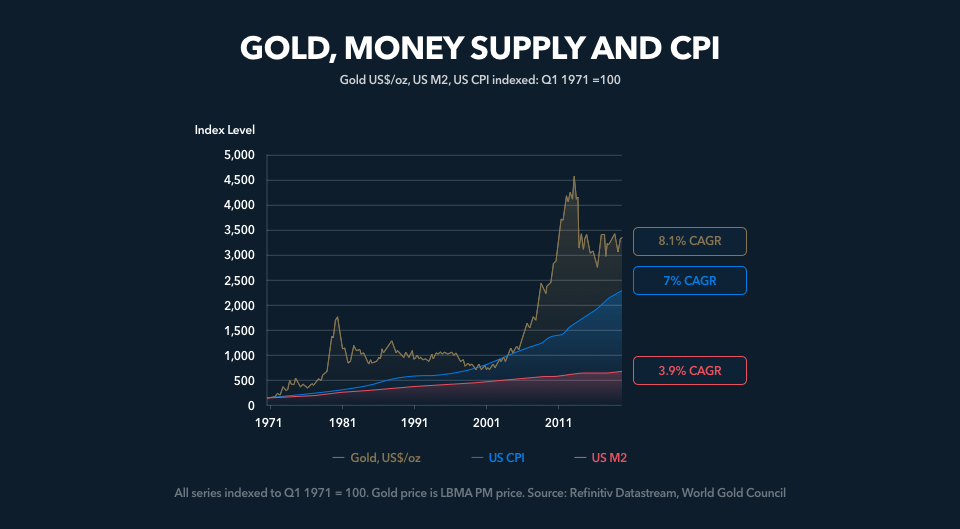With inflation raging and the price of gold seemingly not keeping pace with rising rates, articles suggesting that gold is no longer a valid hedge against inflation or preservation of wealth assets have proliferated in the mainstream financial media.
However, as I’ll show, nothing could be further from the truth. While the price of gold is subject to short-term volatility, an examination of the data over a long period suggests that gold is a perfect ‘hedge’ against inflation.
Inflation and Gold
The term “inflation” is commonly used for rising prices, measured by the Consumer Price Index (CPI). However, this is not technically correct. The economic definition of “inflation” is the rate of increase in the money supply in excess of the rate of increase in economic wealth output.
As Milton Friedman famously said,
“Inflation is always and everywhere a monetary phenomenon, in the sense that it is and can be produced only by a more rapid increase in the quantity of money than in output.”
This aptly describes Central Bank monetary policy in relation to wealth output since Quantitative Easing – aka “money printing” – commenced in late 2008.
Price inflation is thus caused by inflation of the money supply. The concept is pretty simple: when the money supply increases at a rate in excess of wealth output, there are more currency units relative to the supply of “wealth units,” where wealth units represent the number of goods and services supplied by an economic system – leading to more money “chasing” a relatively lesser amount of goods and services.
When this subsequently occurs, the law of supply and demand dictates that price of the wealth units will rise. Let’s take a look at the data. The chart below shows the price of gold vs. the CPI and the M2 money supply going back to 1990):
How does gold hedge against inflation
The chart above shows that, over the last 32 years, gold has worked nearly perfectly as a hedge against both price and money supply inflation. Gold underperformed both inflation metrics from 1996-2001, but this period of time was the final culmination of a bear market in gold that began in 1980. Between 2001 and late 2011, gold outperformed as an inflation hedge, more than compensating for the previous period of underperformance. Since 2016, gold has performed spectacularly as an inflation hedge.
Further supporting this finding, Reuters published a study by the World Gold Council earlier this year that looked at gold as a hedge against inflation. The findings support my conclusion above: “Gold is a proven long-term hedge against inflation, but its performance in the short term is less convincing.”
In other words, because of its commodity price volatility attribute, gold might not be a perfect hedge against inflation in the short run, but works well as a long-term hedge against price inflation caused by the devaluation of fiat currencies from money printing.
The chart above, prepared by the World Gold Council, shows the compounded annual growth rate (CAGR) of gold, the U.S. M2 money supply and the U.S. CPI going back to 1971, where all data is indexed to 100 in Q1 1971.
Again, while there was a brief period in the late 1990s to 2001 in which the price of gold underperformed inflation, over the entire data series, gold outperformed both price and monetary inflation.
Why is gold an inflation hedge?
That’s a question without a scientifically proven explanation beyond the actual statistical data observations.
Over extremely long periods – as in centuries – the increase in the supply of gold annually roughly equals the long-term growth in global economic output. Both were shown to increase approximately 3% annually (“smoothed out” over decades and centuries).
Issuing currency in varying denomination units enables the use of gold as a reserve asset against the issuance of that currency and enables the fungibility of gold – constraining the growth in the supply of currency (money) to the amount of gold that is produced. This can then be used to back currency limits the ability of Central Banks and Governments to “oversupply” currency.
However, since 1971, when the gold-backing of the U.S. dollar as the global reserve currency was completely removed, there have not been any real constraints on currency creation. Since 1971, periods of price inflation have become problematic. It is during those periods when the price of gold not only served as an inflation hedge but also outperformed the inflation rate.
Disclaimer: This publication is for informational purposes only and is not intended to be a solicitation, offering or recommendation of any security, commodity, derivative, investment management service or advisory service and is not commodity trading advice. This publication does not intend to provide investment, tax or legal advice on either a general or specific basis. The views expressed in this article are those held by Dave Kranzler and not Kinesis.
